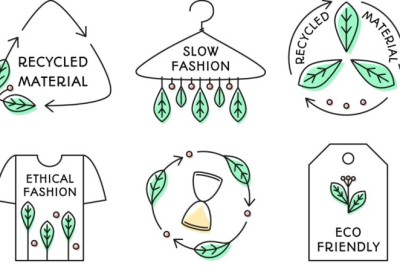views

Fashion Footprint: Calculating and Minimizing Your Environmental Impact
Fashion is an integral part of our lives, reflecting our personalities and cultural identities. However, the industry behind our clothing choices has a significant environmental impact. From resource-intensive production processes to the waste generated by fast fashion, the fashion industry is a major contributor to environmental degradation. Understanding and minimizing our fashion footprint is crucial for fostering a more sustainable future.
Understanding Your Fashion Footprint
Your fashion footprint is the total environmental impact of your clothing choices, encompassing the production, use, and disposal of garments. To comprehend this impact, it is essential to consider various factors:
1. Resource Consumption
The production of textiles requires vast amounts of water, energy, and raw materials. For instance, producing a single cotton T-shirt can consume approximately 2,700 liters of water, equivalent to the average person's drinking water needs for two and a half years. Additionally, synthetic fibers like polyester are derived from fossil fuels, contributing to greenhouse gas emissions.
2. Chemical Usage
The fashion industry is one of the largest users of chemicals, including dyes, bleaches, and finishing agents. These substances can pollute waterways and harm ecosystems if not managed properly. Textile dyeing alone is responsible for around 20% of global industrial water pollution.
3. Carbon Emissions
The fashion industry accounts for about 10% of global carbon emissions, more than international flights and maritime shipping combined. Emissions arise from various stages of the garment lifecycle, including manufacturing, transportation, and disposal. Fast fashion exacerbates this issue by encouraging rapid production cycles and short garment lifespans.
4. Waste Generation
The rise of fast fashion has led to a significant increase in textile waste. On average, each person discards about 70 pounds of clothing annually. A substantial portion of this waste ends up in landfills, where synthetic fibers can take hundreds of years to decompose. Additionally, clothing incineration releases harmful pollutants into the atmosphere.
Calculating Your Fashion Footprint
To make informed decisions and reduce your fashion footprint, it is important to assess the environmental impact of your clothing. Here are steps to help you calculate your footprint:
1. Audit Your Wardrobe
Begin by taking stock of your wardrobe. Identify the types of garments you own, their materials, and their frequency of use. This will provide insight into your consumption patterns and help pinpoint areas for improvement.
2. Assess Production Impact
Research the environmental impact of different materials. Natural fibers like cotton and wool have varying water and pesticide usage, while synthetic fibers like polyester and nylon are derived from petroleum. Consider the production practices of the brands you purchase from, favoring those committed to sustainable practices.
3. Evaluate Usage and Care
Analyze how you care for your clothing. Washing and drying habits can significantly impact energy and water consumption. Opt for cold water washes and line drying to reduce energy usage. Proper garment care can also extend the lifespan of your clothing, reducing the need for frequent replacements.
4. Consider Disposal Practices
Reflect on how you dispose of clothing. Aim to donate, recycle, or repurpose garments instead of discarding them. Many organizations and brands offer recycling programs for old clothing. Additionally, consider participating in clothing swaps or buying second-hand to reduce demand for new garments.
Minimizing Your Fashion Footprint
Once you have a clear understanding of your fashion footprint, take proactive steps to minimize it. Here are strategies to adopt:
1. Buy Less, Choose Wisely
Adopt a minimalist approach to your wardrobe. Focus on quality over quantity, investing in durable, timeless pieces that can be styled in various ways. By reducing consumption, you decrease the demand for resource-intensive production processes.
2. Support Sustainable Brands
Choose brands that prioritize sustainability and ethical practices. Look for certifications like Fair Trade, GOTS (Global Organic Textile Standard), and Bluesign, which indicate responsible production methods. Supporting brands with transparent supply chains and eco-friendly initiatives can drive positive change in the industry.
3. Opt for Sustainable Materials
Select clothing made from sustainable materials such as organic cotton, hemp, and bamboo. These materials typically have lower environmental impacts compared to conventional fibers. Additionally, explore innovative fabrics like Tencel and recycled polyester, which offer eco-friendly alternatives.
4. Extend Garment Lifespan
Take care of your clothing to ensure longevity. Follow proper washing instructions, mend damaged items, and store garments appropriately. Consider learning basic sewing skills to repair minor issues and personalize your clothing, reducing the need for replacements.
5. Embrace Second-Hand and Vintage Fashion
Shopping second-hand and vintage reduces the demand for new production and extends the life of existing garments. Thrift stores, online resale platforms, and clothing swaps offer a wide range of stylish, pre-loved options. Embracing second-hand fashion not only minimizes waste but also adds unique pieces to your wardrobe.
6. Recycle and Upcycle
When garments reach the end of their life, explore recycling and upcycling options. Many organizations accept old clothing for recycling into new textiles. Additionally, get creative with upcycling projects, transforming old garments into new, functional items.
Conclusion
Understanding and minimizing your fashion footprint is a crucial step toward a more sustainable future. By being mindful of resource consumption, production practices, and disposal methods, you can make informed choices that reduce your environmental impact. Embrace sustainable fashion practices, support ethical brands, and prioritize quality over quantity. Together, we can create a fashion industry that values both style and sustainability, ensuring a healthier planet for future generations.











Comments
0 comment